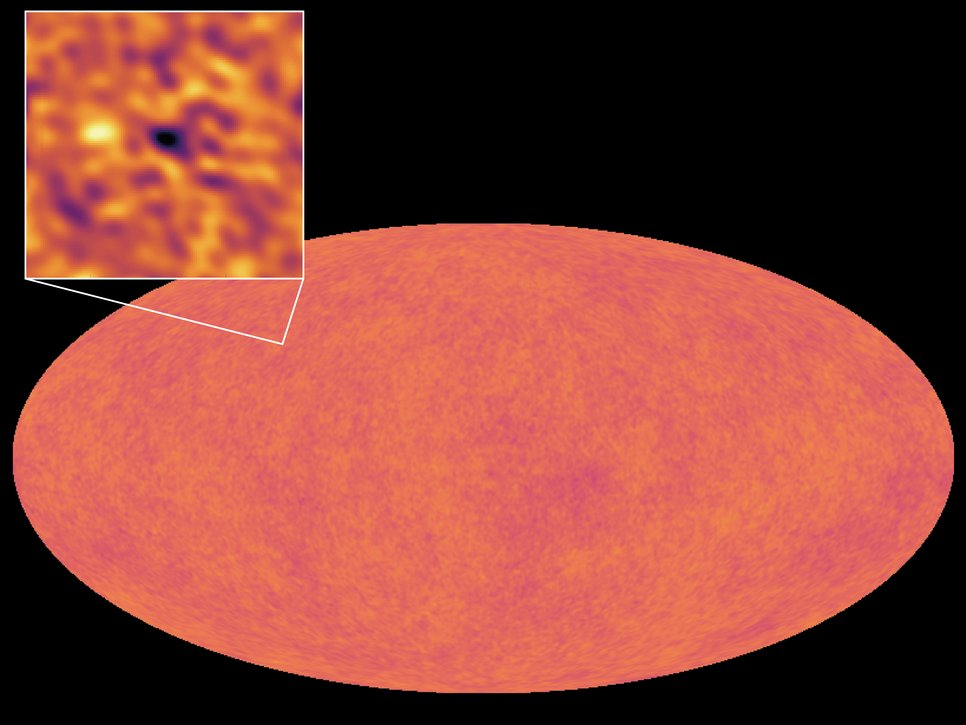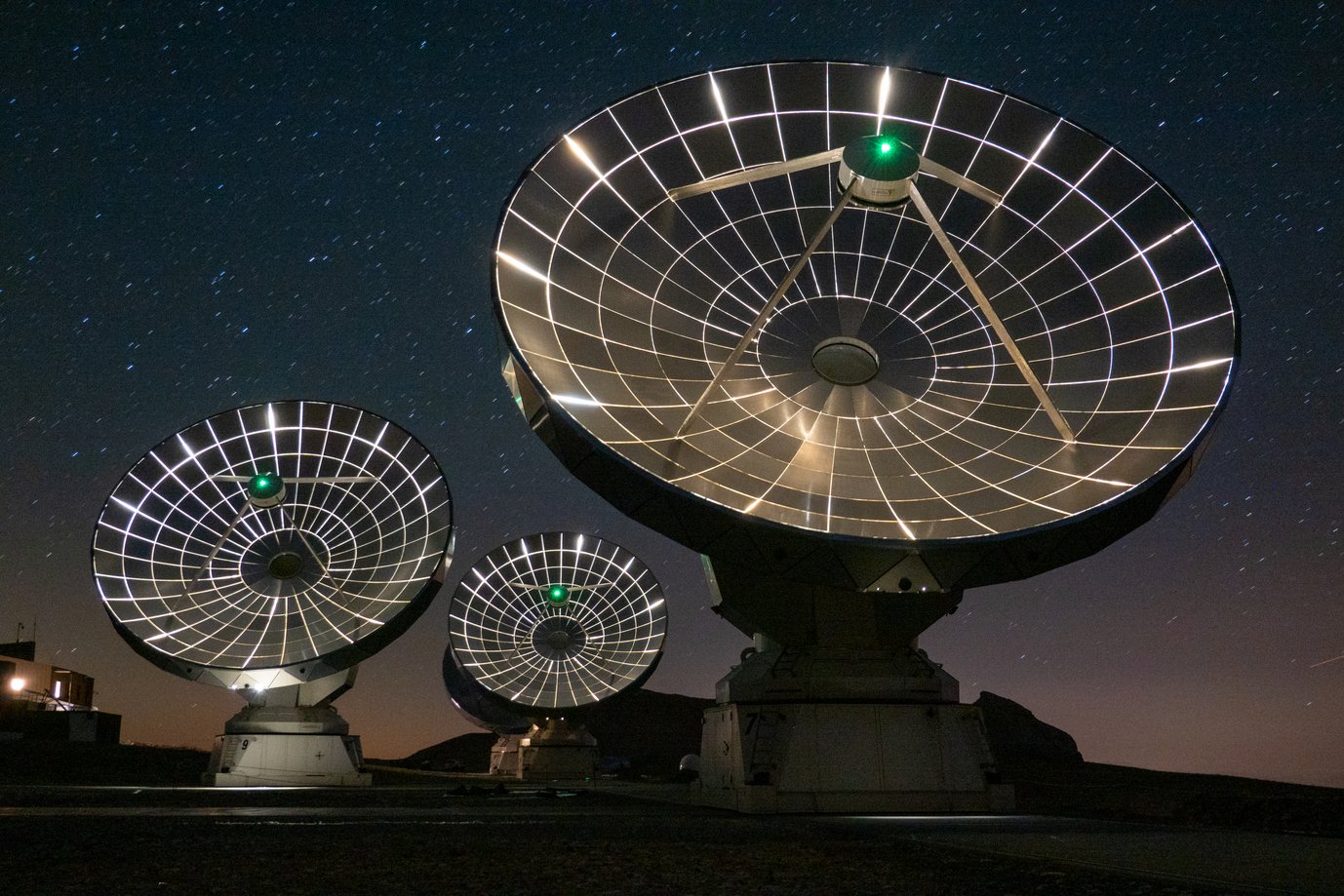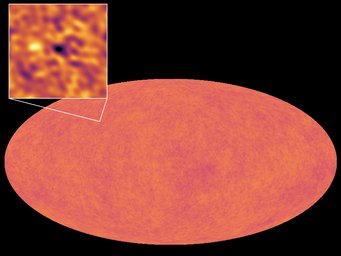Taking the temperature of our cosmos, less than a billion years after the Big Bang
With the IRAM NOEMA telescope array in the French Alps, astronomers have for the first time observed a distant object casting a shadow on the early, hot Big Bang phase of our universe, blocking out some of the light of the so-called cosmic background radiation. The object is a water cloud so distant that we see it as it was a mere 880 million years after the Big Bang. The shadow appears because the colder water absorbs the warmer microwave radiation on its path towards Earth. The degree of darkening reveals the temperature of the cosmic background radiation at that early time: a key data point in our knowledge about our expanding universe. The results have been published in the journal Nature.

Astronomers have made a novel kind of measurements that allows them to measure the temperature of the "cosmic background radiation" filling our cosmos, for early cosmic times. That radiation, a remnant of the hot Big Bang phase of our cosmos, has been cooling down continually. Determining its temperature at an early time, in this case 880 million years after the Big Bang, provides an important consistency check for our cosmological models.
A cooling universe
Around 13.8 billion years ago, in what cosmologists call the Big Bang phase, the universe was in an extremely hot and extremely dense state, filled with a plasma of radiation and elementary particles. But even at that time, the universe was expanding, with its density decreasing quickly over time. By the laws governing thermodynamics, such a decrease in density corresponds to a decrease in temperature: the plasma expands, becomes less dense, and cools down. In line with the plasma, the thermal radiation cools down as well – the light particles (photons) flitting through the plasma, interacting with the electrically charged particles, become ever less energetic.
After a few hundreds of thousands of years, the plasma had cooled down sufficiently for atoms to form. Before that time, the temperature was so high that if, say, a proton and electron would come together to form a hydrogen atom, that atom would almost instantly have been split apart (ionized), the electron driven away, by a highly-energetic photon, leaving no atom behind.
Viewing the (hot and dense) past
But as the plasma and the thermal radiation cooled down, there were fewer and fewer high-energy photons around. More and more atoms were able to form without having their electrons kicked away by high-energy photons. By the 380,000-year mark, almost all of the atomic nuclei (mostly hydrogen, with some helium-4 thrown in) had combined with electrons to form electrically neutral atoms. From that time onwards, there was very little interaction between those atoms and the remaining thermal radiation. That radiation, which astronomers call the cosmic background radiation, continued to propagate through space virtually unchanged.
This is where a basic truth of astronomy becomes important. Light from astronomical objects always takes a certain time to reach us. In consequence, we never see, say, the Sun as it is now. Our observations always show the Sun as it was 8 minutes ago, when the light reaching our telescopes now left the surface of the Sun. Similarly, we always see the Andromeda galaxy as it was about 2.5 million years ago, as it takes light 2.5 million years to travel from that galaxy to our telescopes here on Earth.
Our window onto the hot Big Bang phase
But this means we can still observe that primordial cosmic background radiation today! Space, after all, is comparatively empty. If we avoid looking into our own Milky Way galaxy's dust clouds, and into the stars of distant galaxies, then we can look farther and farther into space – that is, until we are looking at regions that are so far away that their light takes 13.8 billion years to reach us. Those regions, we see as they were 13.8 billion years ago – and remember: at that time the universe was in a hot, dense plasma state.
More specifically, we cannot see into that plasma, as plasma of that kind is opaque. But we can see as far as the time when the cosmic background radiation was released. Put differently: There are regions in the universe that are just the right distance from us so that their cosmic background radiation reaches us at the present time. We can, today, see and measure the light from the end of the hot Big Bang phase, and measurements of that kind have yielded valuable information about the early, hot universe.
There is one important additional effect: We are not just seeing this radiation from very distant regions in an otherwise unchanging universe. Instead, from that early time to the present, the universe has been expanding, and cosmic expansion has the effect of cooling down the early thermal radiation ever further. Thermal radiation of that kind is fully described by a single parameter, its temperature, and in our cosmological models, the effect of cosmic expansion on that temperature is straightforward: In the time that distances between distant galaxies have increased by a factor 2, cosmic background radiation temperature will have fallen by one half.
Expanding universe, cooling radiation
From the time the cosmic background radiation was released to the present, the universe has expanded by a factor of about 1100. The cosmic background radiation, which originally was at a temperature of around 3000 Kelvin and resembled light from some of the kinds of floodlight used to light athletic fields (metal-halide lights), cooled down by that same factor. These days, it reaches Earth mostly in the form of low-energy microwave radiation, which is why another name for it is the "cosmic microwave background", abbreviated CMB.
The direct link between the expansion of our universe and the CMB temperature means that, over time, the cosmic background radiation carries very valuable information indeed. If we could measure the CMB temperature at different times in cosmic history, we could reconstruct how, in detail, our cosmos has been expanding. This "expansion chronology" is one of the most basic data sets we can obtain about the history of our universe. It is directly linked to one of the great unknowns of modern cosmology: so-called dark energy, an ingredient filling our universe that is responsible for the fact that, at present, the expansion rate of our cosmos is increasing – cosmic expansion is accelerating.
Tracking cosmic expansion, one temperature at a time
What a direct measurement could show is whether this direct link between the expansion of our universe and the cooling of the CMB does indeed hold. A comparison with an alternative measure of cosmic expansion, the so-called cosmological redshift, could rule out some more exotic proposals for the nature of dark energy. Dominik Riechers, the lead author of the University of Cologne, says: "If there were to be any deviations from the expected trends, this could have direct implications for the nature of the elusive dark energy."
Notably, a deviation from the direct link would be expected in models in which dark energy "decays", transferring some of its energy to the regular matter and radiation in the universe, which would slow the cooling of the CMB. Some models for the other big unknown in cosmology, Dark Matter, would include similar effects: Certain exotic (and as yet undetected) elementary particles proposed as the constituents of Dark Matter, so-called light axions, could interact with the cosmic background radiation, influencing the way it cools down over time.
However, measuring the CMB temperature at different times in cosmic history is rather difficult. There are some data points: For the cosmic history over the past 6 billion years (redshifts z between 0 and 1), the so-called Sunyaev-Zel’dovich effect provides a way for such measurements. A bit farther out, between 10 and 11.7 billion years before the present (z between 1.8 and 3.3) there are data points indicating that the CMB temperature has just the right value to excite specific energy levels in certain species of atoms or molecules.

Taking the temperature of the cosmos, 880 million years after the Big Bang
The present results go considerably beyond this, contributing a CMB temperature data point from a time nearly 13 billion years before the present – a mere billion years after the Big Bang phase. The protagonist is a cloud of cold water in a starburst galaxy with the catalogue number HFLS3, which we see as it was about 880 million years after the Big Bang. Just as the CMB itself, light from that galaxy is heavily redshifted. All observations for this work were made with the IRAM NOEMA telescope array in the French Alps, a radio observatory that observes at millimeter wavelengths.
A starburst galaxy gets its name from the fact that it has recently produced an unusually high number of new stars in a short period of time. This particular starburst galaxy contains a sizeable cloud of water vapour, H2O, and the CMB acts like a light source that, from the point of view of observers, is behind the cloud. Astronomer know similar situations as they observe stars. In a star, the lower, hotter layers of the so-called photosphere produce almost all of the star's light. But directly above are somewhat cooler layers of gas. The result are so-called absorption lines: specific wavelengths where the starlight is absorbed by the cooler layers. When astronomers look at the rainbow-like spectrum of a star, those absorption lines indeed appear like darker, line-shaped shadows on the rainbow.
A tell-tale shadow on the cosmic background radiation
The simple version of the new result is very much like that: The water vapour cloud is cooler than the cosmic background radiation. For that reason, it casts a shadow on the cosmic microwave background, something that astronomers had never seen before in the early universe: an absorption line in the rainbow-like decomposition of the CMB, with the strength of the absorption indicating the temperature difference to the cloud – and, by implication, the temperature of the CMB as it passed through the cloud 880 million years after the Big Bang.
Full disclosure: The nitty-gritty details of the situation are somewhat more complicated. The cloud temperature in question is not the temperature of the cloud as a whole, but the temperature corresponding to how many of the water molecules are in a slightly excited (rotation) state relative to the lowest-energy ground state. There is a basic formula linking the fraction of water molecules in the excited state with a temperature; conversely, by measuring how many excited water molecules there are, one can determine that specific temperature.
The fact that this pair-of-states-temperature is lower than that of the CMB comes about only thanks to the infrared light emitted by the galaxy's many newborn stars – that, after all, is what a starburst galaxy is: a galaxy that is undergoing a short phase of forming many more young stars than usual – and tempered by the galaxy's clouds of dust. That infrared light effectively shifts the balance of how many molecules are in what particular state – and for the pair of states examined by the astronomers for this study, this is equivalent to a lower temperature, resulting in the creation of a CMB absorption line.
Constraining cosmic evolution
Whether in the simpler or in the more complicated version: The end result depends on the CMB temperature. From their observations, the astronomers deduce that the CMB at that time must have had a temperature between 16.4 and 30.2 Kelvin. This is consistent with the temperature of 20 Kelvin predicted for that time, 880 million years after the Big Bang, by the current cosmological models – given the direct connection between CMB cooling and the cosmic expansion history, an important consistency check.
With this result, the exotic models that predict a disconnect between the temperature and the expansion rate can be excluded. More generally, we now have a data point about cosmic expansion from a period in cosmic history from which there are very few data points to begin with. Fabian Walter, MPIA astronomer involved in this research says: "This new technique provides important new insights into the evolution of the universe, and shows us that the universe in its infancy had some unusual properties quite unlike today.” This is because this particular kind of effect can only occur in the very early universe, before the CMB had cooled down further.
HFLS3 as the prototype for an early temperature survey
Now that their early-universe data point is fully analyzed, the researchers are planning for the future. Other starburst galaxies like HFLS3 are known in the early universe, and several of them are known to contain clouds of water vapour. The researchers are now searching in a systematic way for additional examples for the shadow effect using NOEMA, which might allow them to map the cooling of the cosmic background radiation, the echo of the Big Bang, more closely over the first 1.5 billion years of cosmic history.
Background information
The research described here has been published as D. Riechers et al., "Microwave Background Temperature at Redshift 6.34 from H2O Absorption" in the journal Nature.
The MPIA scientist involved is Fabian Walter, in collaboration with Dominik Riechers (Cologne University), Axel Weiss (Max Planck Institute for Radio Astronomy), Christopher L. Carilli (NRAO), Pierre Cox (Sorbonne Université and CNRS), Roberto Decarli (INAF Bologna) and Roberto Neri (IRAM).
NOEMA is the most powerful millimeter telescope in the Northern Hemisphere. The observatory operates at over 2500 meters above sea level on one of the most extended European high-altitude sites, the Plateau de Bure in the French Alps. The telescope is operated by the Institut de Radioastronomie Millimétrique (IRAM) and is financed by the Max-Planck Society (Germany), the Centre National de Recherche Scientifique (France) and the Instituto Geografico Nacional (Spain).
Figure 1 is based on observations obtained with Planck (http://www.esa.int/Planck), an ESA science mission with instruments and contributions directly funded by ESA Member States, NASA, and Canada.
Journalists can request access to the Nature article under press@nature.com

